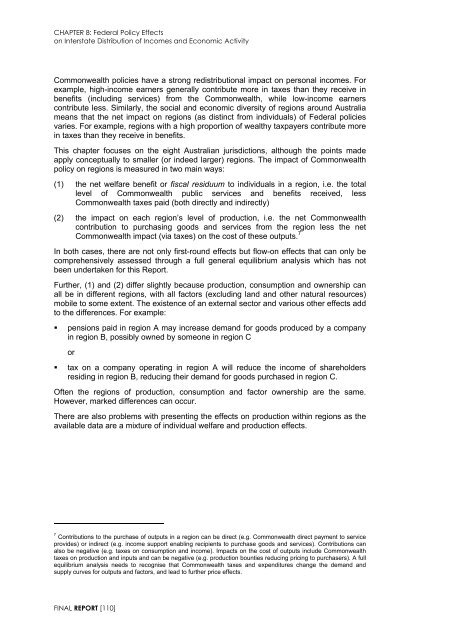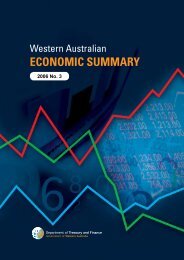Garnaut Fitzgerald Review of Commonwealth-State Funding
Garnaut Fitzgerald Review of Commonwealth-State Funding
Garnaut Fitzgerald Review of Commonwealth-State Funding
Create successful ePaper yourself
Turn your PDF publications into a flip-book with our unique Google optimized e-Paper software.
CHAPTER 8: Federal Policy Effects<br />
on Interstate Distribution <strong>of</strong> Incomes and Economic Activity<br />
<strong>Commonwealth</strong> policies have a strong redistributional impact on personal incomes. For<br />
example, high-income earners generally contribute more in taxes than they receive in<br />
benefits (including services) from the <strong>Commonwealth</strong>, while low-income earners<br />
contribute less. Similarly, the social and economic diversity <strong>of</strong> regions around Australia<br />
means that the net impact on regions (as distinct from individuals) <strong>of</strong> Federal policies<br />
varies. For example, regions with a high proportion <strong>of</strong> wealthy taxpayers contribute more<br />
in taxes than they receive in benefits.<br />
This chapter focuses on the eight Australian jurisdictions, although the points made<br />
apply conceptually to smaller (or indeed larger) regions. The impact <strong>of</strong> <strong>Commonwealth</strong><br />
policy on regions is measured in two main ways:<br />
(1) the net welfare benefit or fiscal residuum to individuals in a region, i.e. the total<br />
level <strong>of</strong> <strong>Commonwealth</strong> public services and benefits received, less<br />
<strong>Commonwealth</strong> taxes paid (both directly and indirectly)<br />
(2) the impact on each region’s level <strong>of</strong> production, i.e. the net <strong>Commonwealth</strong><br />
contribution to purchasing goods and services from the region less the net<br />
<strong>Commonwealth</strong> impact (via taxes) on the cost <strong>of</strong> these outputs. 7<br />
In both cases, there are not only first-round effects but flow-on effects that can only be<br />
comprehensively assessed through a full general equilibrium analysis which has not<br />
been undertaken for this Report.<br />
Further, (1) and (2) differ slightly because production, consumption and ownership can<br />
all be in different regions, with all factors (excluding land and other natural resources)<br />
mobile to some extent. The existence <strong>of</strong> an external sector and various other effects add<br />
to the differences. For example:<br />
• pensions paid in region A may increase demand for goods produced by a company<br />
in region B, possibly owned by someone in region C<br />
or<br />
• tax on a company operating in region A will reduce the income <strong>of</strong> shareholders<br />
residing in region B, reducing their demand for goods purchased in region C.<br />
Often the regions <strong>of</strong> production, consumption and factor ownership are the same.<br />
However, marked differences can occur.<br />
There are also problems with presenting the effects on production within regions as the<br />
available data are a mixture <strong>of</strong> individual welfare and production effects.<br />
7<br />
Contributions to the purchase <strong>of</strong> outputs in a region can be direct (e.g. <strong>Commonwealth</strong> direct payment to service<br />
provides) or indirect (e.g. income support enabling recipients to purchase goods and services). Contributions can<br />
also be negative (e.g. taxes on consumption and income). Impacts on the cost <strong>of</strong> outputs include <strong>Commonwealth</strong><br />
taxes on production and inputs and can be negative (e.g. production bounties reducing pricing to purchasers). A full<br />
equilibrium analysis needs to recognise that <strong>Commonwealth</strong> taxes and expenditures change the demand and<br />
supply curves for outputs and factors, and lead to further price effects.<br />
FINAL REPORT [110]

















